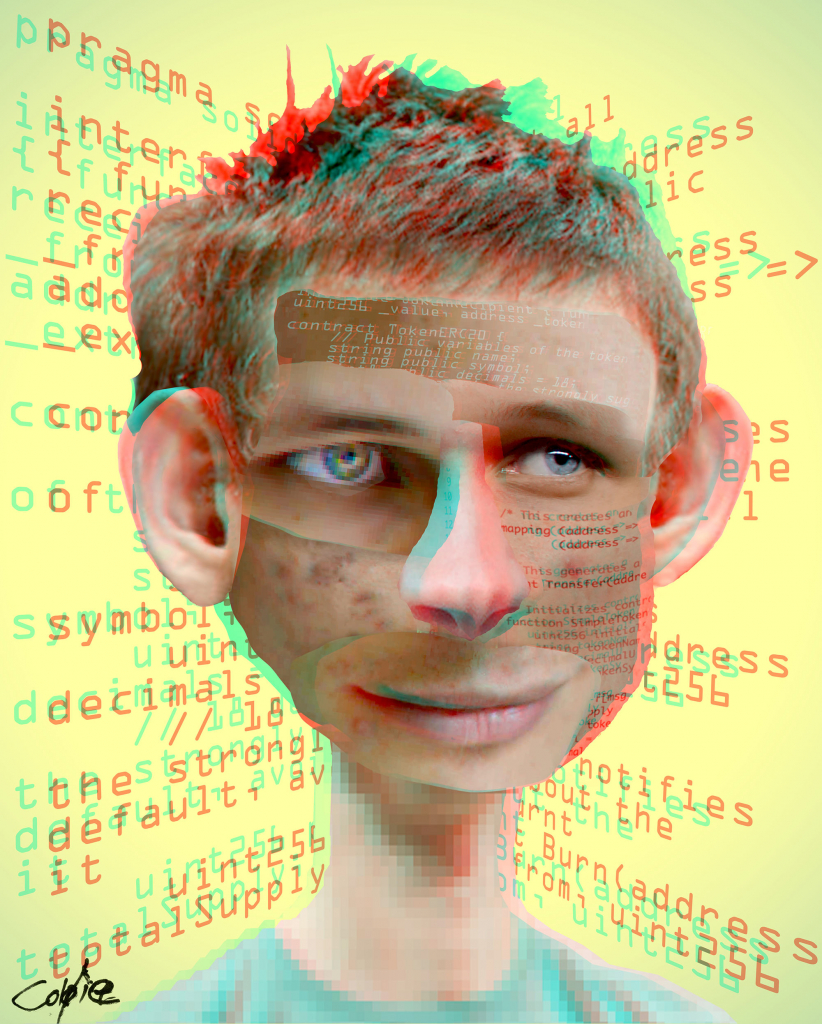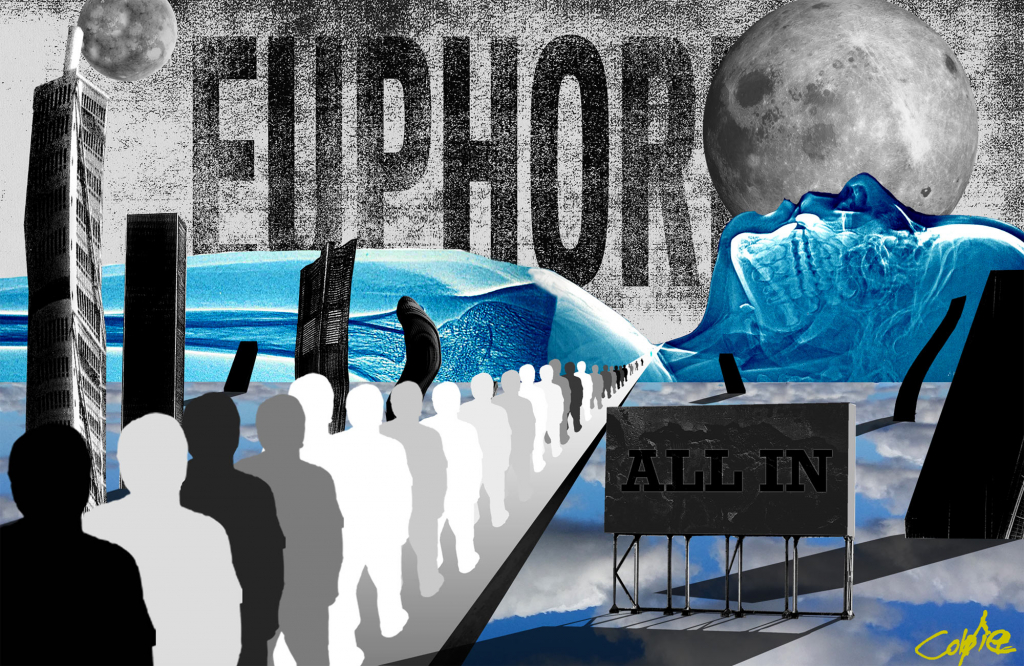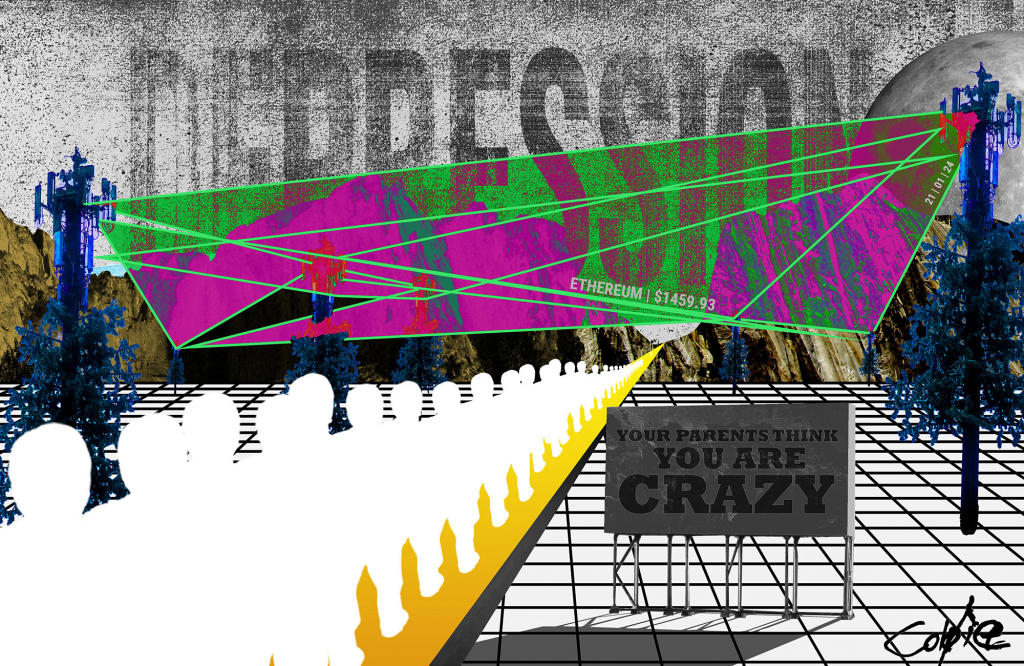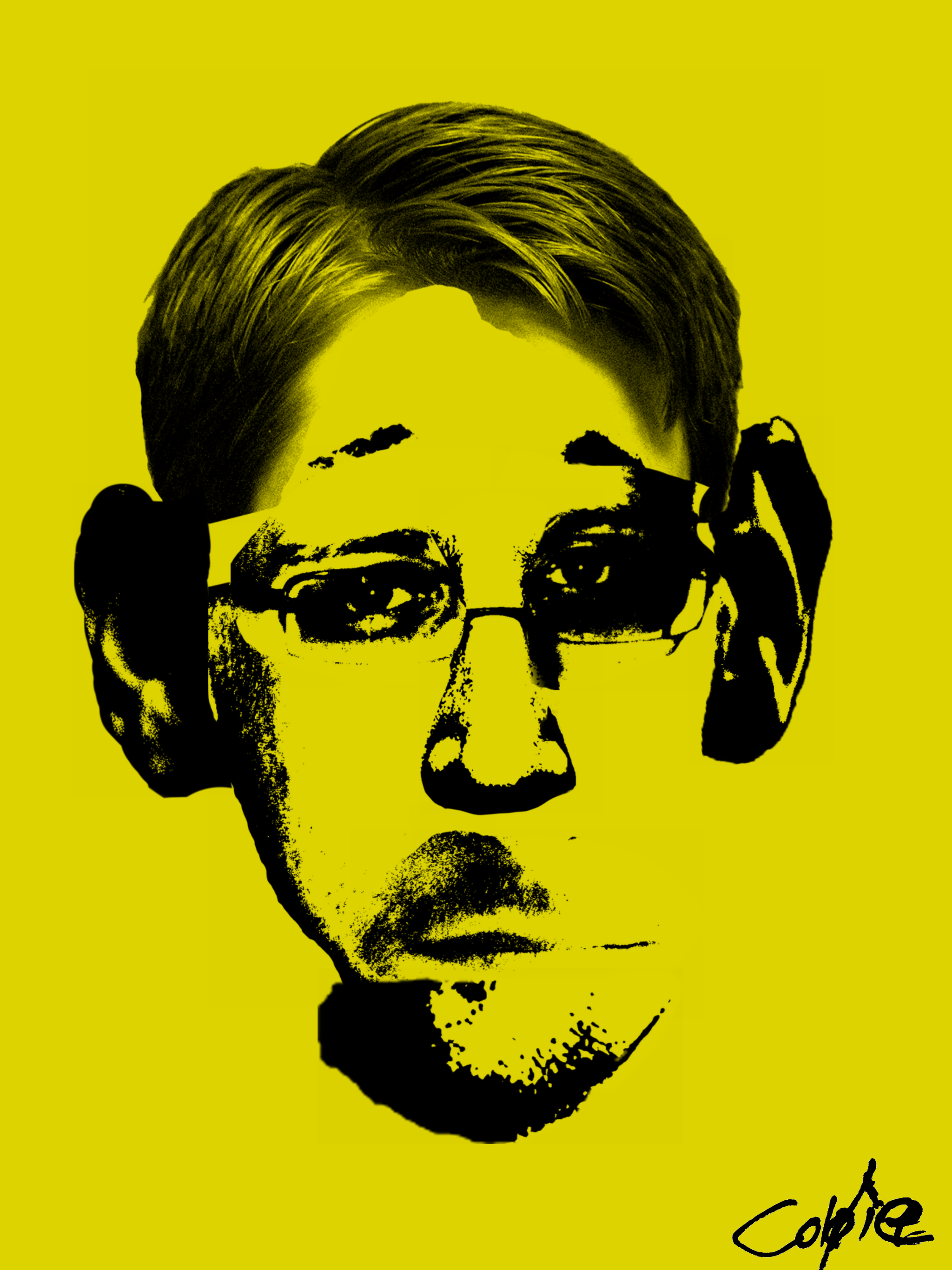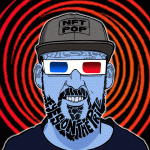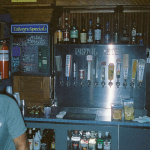Taking a flat plane and fooling the viewer that the image is no longer flat, but instead has depth both forward and backward in space. That space is where I want to create.
Ryan (Coldie) Colditz
LEFT: Proof Of Work – Genesis (on auction @ Bonhams)
By Luke Whyte, Editorial Director
Calling California-based mixed media artist Ryan (Coldie) Colditz’ art “3D” doesn’t really do it justice. Combining source materials from a variety of mediums with stereoscopic techniques and shifting focal points, one seems to fall into Coldie’s work only to be spit back out with more questions than answers, like staring into one of those Magic Eye posters from the ‘90s.
This depth in perspective is matched by a depth in narrative. His work mixes socioeconomic statements with metaphysical metaphors to tell stories about our place in history and in the universe.
We sat down to discuss these visions, his experience in the NFT community and Proof of Work – Genesis, the artwork to be auctioned in the SuperRare x Bonhams collaboration.
Click here to visit the Bonham’s CryptOGs auction page.
LW: Can you talk a little bit about how you got into digital art in the first place? When did you start as an artist?
RC: The very first place I did digital art was at my grandparents house who had one of the first Macintosh box computers. I was about 5 years old and my grandpa would load up ‘Paint’ and I would play around. I vividly remember using the fill tool to make a brick background and drawing on top of it with the marker, doing some type of graffiti. Then I remembered that all I had to do was double click a button and it will all wipe away and I could start over. I had no prior interest in art or creativity like this, but even at that time I could tell it was something that I wanted to investigate further.
I would consider myself starting creating art in 2010 when I moved from Los Angeles became to my hometown to live with my parents. It was a transitional time for me and while I was in LA I had come up with so many ideas, I needed time and space to create and in my parents basement was where that happened. These unique techniques from professors at Cal Poly Pomona allowed me to take my digital art and put it onto a canvas. It was the process and medium together that took my digital ideas into being art on canvas. Those early works I still own and they are a testament to ‘going for it’ and doing the very best with what you have available.
LW: You worked as a graphic designer with LA Weekly and as an art director, do you feel that work shaped you as an artist?
RC: Those LA Weekly years were definitely what shaped and formed my brain early on for creating art in a fast-paced environment, where the wild idea was applauded, but it must be executed correctly the first time due to the nature of the weekly paper publishing. It was also a really fun challenge because I would be given a few small JPEGS by the writer and told to use these for the artwork. Often the artwork was totally not usable and I had to riff off the images to create something totally unique, many times with only a few hours to go from concept to final production art.
As I developed into an art director, these same skills would come into play, but now I was both designing at times as well as giving others direction of what to create. It’s always a give and take with art direction because I want to honor each artist’s vision and talents and its finding how their secret sauce can accentuate an idea in perhaps a different way than I had visualized in my own head. Teamworks has always been my mantra with art and design. When all parts come together and add a unique touch, that is a winning project.
LW: What does it feel like to finally be able to quit your day job and focus on art? Is it intimidating to be out on your own now?
RC: Over the last year, it was becoming more and more common for artists in the space to reach out to me, asking how I was able to do a full-time art director job as well as create art. My response was that I didn’t have a choice and I was trying to make both work. For the past 11 years of making fine art, my goal was always to do my best work, and find ways to carve out a little more time to focus on the art and shift the focus from commercial work to my own passion projects. I grinded HARD at all times. Most nights I would work my job, take care of family responsibilities, then around 9PM I would have a little bit of “my time” that I would alway devote to creativity. The problem with this was it was always when I was wiped out and I considered it ‘trash time.’ I was always driving to photograph concerts with my 3D camera. I never got paid a dime for all the time and energy it took to make these projects happen. I create for the pure joy and passion and I only like to make things that interest me. With such a healthy does of ADD, I was always trying to outdo the last project to give myself something new to learn and grow. To me, sweat equity is the best way for anyone to get places they want to if they don’t have money to fund it. The hard work becomes its own currency and fruits of the labor is the art.
My solution to this dilemma was that during my day, no matter what it was, I was mentally designing the artwork I would do at night. I was literally mentally moving layers around, changing scale, testing collage layouts in my head. I would make so many stylistic decisions or at least boil down to a few optional solutions that when my free time would happen, I was able to very quickly execute the idea that had been percolating in my head and come up quick progress. This points back to my LA Weekly days of efficient use of time and effective art making skills to make my ideas come to fruition most efficiently.
As the crypto art community grew, i was in a creative flow and through that was building my own style and voice, the opportunity to change that balance to fine art became an reality. I would continue to get the questions asking how I did both the art director job and art, and it became harder to answer. It was a LOT and the strain was taking its toll. I was still giving everything my total effort, but I saw that there was a huge opportunity that if I were to go all-in with art, that the possibilities far outweighed the fulfillment of commercial art and design. I literally held onto both as long as I could but now that I am on my first day of not having the art director job, I have never been more excited to get to work. I have decades of dreams that were never possible. Now, every single one is, and over the last decade my skills to execute those dreams is greater. I truly feel like I have just started a new renaissance period in my own life.
LW: Do you consider yourself a collector as well as an artist? Why do you collect other artists work?
RC: Now, I consider myself a collector as well as an artist. In my 20s living in Los Angeles, absolutely not. The major distinction is that I never had a means to collect. Both in terms of the monetary as well as the storage space. What I used to do in LA while at LA Weekly was going around to all the galleries and openings in town. I would study every show. The font on the window titles. The reception booklet. The arrangement of the pieces. The amount of people in the room and seeing who was actually there for the art, or for scenester reasons. I would study the fuck out of pieces that caught my eye. Would get up really close to see how the paint sat on the canvas. How the artists dealt with the sides of canvases. I always smiled when I saw an artist would continue the art around the edge. This whole time, I was broke as a joke. I would go around and pretend I was a collector and I would pick my favorites. This practice was not only a cheap way to mentally collect art, but it began to shape my taste about what I appreciated in other people’s art. Many times it would be way different than what I made. I could fall in love with a knitted blanket if it was done in such a way that amazed me.
Once NFTs started happening and I was on SuperRare, I was surrounded by some really amazing art and moreso the artists who were making the art. We were a little family and all inspiring each other and experimenting. I never felt ANY competition from others and I never tried to compete. I was so taken back by what was happening that I began to use a portion of my art sales earning to reinvest into the ecosystem. Part of me was collecting art that hit me just in the same way as the LA gallery days, but this time it was different. I KNEW these people and I wanted to capture that magic in a way that spread some love back around and inspired new thoughts.
I have a pretty vast collection after 3 years of being in crypto art and NFTs. When I look at them all together, its really cool because I can definitely break my colleciton into several major chunks of interest. I was all-in back in 2018 just as much I am in 2021. I am even more all-in because all the speculation about where this was all headed was just that, a “dream”. But dammit, we made those dreams a reality. Everyone did. No single artist can be pinned down as the “one” who did it. That is why my collection means so much to me. It is time capsule of all my really cool and talented friends creating art and expressions for the pure love of art making.
LW: Can you talk about how your work plays with 3D, depth and perspective shifts? Do you see your work pushing into VR?
RC: Taking a flat plane and fooling the viewer that the image is no longer flat, but instead has depth both forward and backward in space. That space is where I want to create. I had a choice early on, I remember I was at a summer art camp at Fresno State where I was taking an intensive class on printmaking and bookbinding. A few doors down was the computer lab where 3D modelers were learning how to do 3D animation. I remember my soul stopping for a moment and asking, ‘is this the 3D you want to do?’ The answer was no.
I wanted to use stereoscopics to create the dept effect I was looking for. It was different. A lost art. Something that has so many rules to do it correctly. I learned all the magic and tricks of the trade by legends in the stereoscopic 3D space including Ray Zone and Roger May who are the two best 3D comic book artists of all time. That is where I developed and grew and was mentored by two legends who knew I was hungry to learn and could have the potential to help keep this niche alive and relevant for a new era.
In 2008 I went to a stereoscopic 3D art gallery opening curated by Ray Zone. I wish I could have 3D scanned that room. That was one of those experiences that completely changed what was important to me as an artist. Ray did a presentation of some of his illustration graphic design in 3D. I nearly fainted. Seeing what he did technically, I knew that I wanted to do that with my own style of art.
In 2009 I decided that I wanted to build a 3D camera like everyone else at the Los Angeles 3D Club was using to make stereoscopic photos. So I hacked my own twin-lens camera together and the only thing that I wanted to do was photograph my favorite bands in 3D. When I began to shoot these photos, I realized that for most people to see them in 3D, they needed red/blue anaglyph glasses. This also meant that often black and white was the best way to view the images due to the issues of blues and reds in an anaglyph photo. It was then that I had a massive vision and dream. Someday, SOME-DAY, SOMEDAY, there would be a way to view these 3D concert photos in full color 3D with depth.
And you ask about going into VR. Let’s tie this all together. Several months ago a friend from the stereoscopic 3D club struck up a conversation with me on a Facebook group we share. I asked him if there was a way to view my photos in VR. When he showed me the first photo of mine in 3D, I broke down crying. The years and years of shooting and having a vision for the future had come true. I cannot wait to release my 3D concert photography archive. It will be a lot of fun to share and I think an unparalleled collection that many will enjoy.
In addition to this image based for of VR art creation, I am also currently creating VR which I consider environmental sculpture, rather than a flat plan composition. Recently I chose to airdrop the very first Decentral Eyes VR portrait to all my current collectors of then portrait collection. A big thank you for the support over the years and a fun way to kick off a huge evolution in my art making.
LW: What was the drive and inspiration behind your portrait series?
RC: The Decentral Eyes portrait series is the most unlikely series, if you were to look at the art i was making prior. Never had I even gave a shit about a human face in my artwork. An Andy Warhol portrait exhibition that randomly found its way to Sacramento, CA. and since shows like this NEVER come to my area, I went, but not expecting to be totally excited, because prior I was very into his graphic collage and distressed multiples. The portraits hit me in the face like a ton of bricks. I realized that history and art are important. Faces give context and grounding to the world around it. When I began making crypto art, I wanted to first off challenge myself with a project way outside my normal. So portrait was a great decision. I also wanted to visually show the facets that in real time were shaping the times of crypto and blockchain.
As a collage artist, I wanted to figure out a way to do a portrait “my way” and the idea of a decentralized portrait came to me once i started breaking down the words themselves. Decentral and Eyes could not have been a better name because it was inherit to the movement itself. It was a collection of face photos found all over the net. They were cut up, and mashed together to create a new portrait of the subject. This process is very fun and actually some of the best times of each new subject is finding the 10 different images pieces that will reform the face.
Choosing a subject is ultimately the biggest consideration and challenge. At first I was focusing on the “heros” of the movement, but once I began to look at the “villains” were a perfect addition to the total historical chronology of this series.
The 3D effects used from start to now is also its own beautiful progress evolution. Each piece i want to grow from the last. If you line up all the portraits in order (which I have done on one of my CryptoVoxels galleries) you see the evolution. It has gone from JPEG, to GIF, to MP4, and now to new VR formats. Once this project does not give me ways to grow and experiment, I’ll be done. Thats how I look at all my projects. The exciting part is that the tech being developed now is going to keep blowing my mind and inspiring the next experiment.
LW: Regarding Proof of Work, whats the inspiration for this piece?
RC: I grew up in the home town of the start of the California Gold Rush. Everything around me growing up was either a miner logo, gold rush in the business names, or the mining stores where you can still buy the supplies. This culture runs deep and always has. There was the sense of opportunity that alway struck me, even as a 10 year old visiting Coloma for the first time. It became the most sacred land. The place that opportunity met with hard work and instincts.
Decades later, when I found cryptocurrency and blockchain. I knew that I was experiencing a fractal. All that had happened then, is now happening in real-time. I could break down a mining campt into all the different pieces of the current day gold rush that is happening. Those who made the tough trek to find the gold fields, now has the opportunity if they put in the work.
The nearly direct symbolism of the mining machine solving equations to earn the block reward is no different than a gold miner digging pans of rocks looking for the piece of gold. It was the “AH HA” moment when I made that connection that really set the wheels in motion to creat this piece.
LW: What did the digital art landscape look like before NFTs? Were you struggling to make ends meet as an artist?
RC: Digital art was something I was making for myself. No one ever wanted it and that was fine with me. My stereoscopic 3D art was much different than other stuff on social media, so there wasnt a lot of similar artists circles to integrate with. I am quite proud that I got two anaglyph 3D sterescopic artworks juried into nation juried art exhibitions. I was always told that 3D anaglyph got zero love from the traditional art work, so when I had two piece selected by different juniors who were highly respected in the contemporary art space, that was a big deal to me. Funny story was, they changed the price on my piece from my asking price of $1,200 down to $600 without asking me. They just couldnt see how that price made any sense. I was just happy to be there, but that little move was great market research feedback.
I would do art walks and get my stuff up on barbar shops and coffee shops around Sacramento. There was one corner of town i had shows on 3 of the 4 corners, I thought that was cool. I sold a few lenticulars at these pop up shows, and it was always very cool to meet the people who wanted the art and I made a point or “reason” that I needed to meet them to get them the art. I wanted to talk to collectors because it is really interesting what it is that pushes people over the edge to want to buy art in the first place. But again, I was not making any money. Probably enough to offset the costs, if I was lucky.
LW: What did it feel like to realize you were arising as a leader in the NFT space, being seen as an OG and getting a great market value for your work?
RC: Being a leader is something that takes initiative. From the beginning I was a proponent for the space. I gave interviews to whoever wanted to talk, I began engaging in conversation on Twitter, and overall want to help cultivate the space. I felt that if everyone just did a little bit, it would move quicker towards mass adoption. That is my end goal with all of this is to help move the bar forward.
Leading also mean taking risks. Sometimes those risks are triumphant wins and other times they are a faceplant. All the faceplants in life help you take new risks. The risk to me now was NOT giving all I had. Some of my risks were really unexpected including coming up with a variation to a reserve auction that I came up with on my own in order to try and create a fair, level playing fiend for NFT collectors. Now it has been adopted and used by many platforms and artists as the preferred way to sell digital art, now coined “The Coldie Method™” Those are the weird and wild things that happen when you lead.
Being an OG to me is a major badge of honor. Entering the scene when there wasnt a scene and selling 1/1s for $100 was really fun. I knew I was making good art and I was excited for the collectors who purchased them. We were vibing and honoring each other and because of that, all this grew. If anything, it was not about the money at all. I loved seeing others tokenize with no warning and be blasted in the face with something new and unexpected. We would chat and dream of a day that crypto art would be adopted by the world. We all knew it would cuz we proved the use case. Once that was established, then business knows what to do with that opportunity. I have about a billion stories I could tell about early times. I miss those days a lot for what they were, but now is even better in full of opportunity.
I am an artist. I will be creating no matter what. NFTs have offered me the latest and greatest challenge to create art that amazes me. If NFTs went away tomorrow, I still have dozens of projects to do. I look forward to where everything is headed and if it wasnt for the hard days, the hustle and grind, and the vision for what was possible, these special events that allow us to stop and celebrate would not taste nearly as sweet and fulfilling.
Read the next article in the CryptOGs series:
Luke Whyte is SuperRare's Editorial Director.

